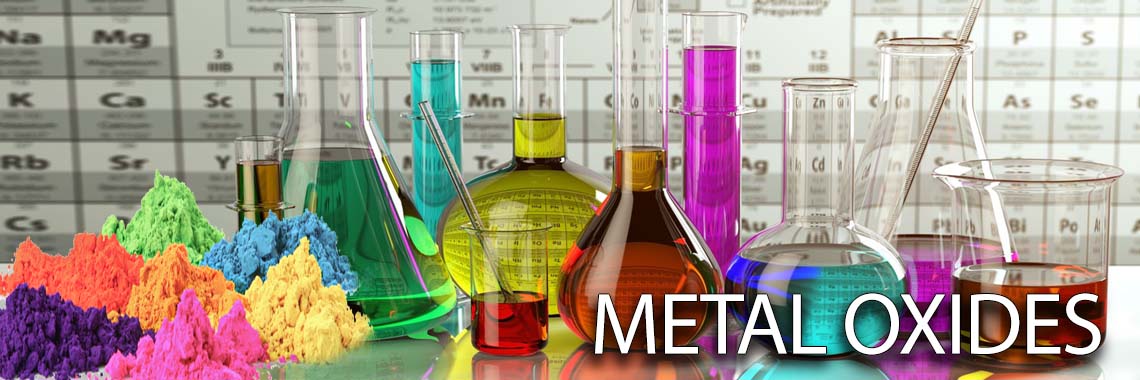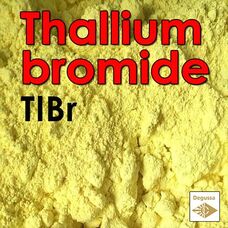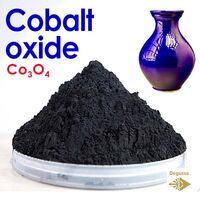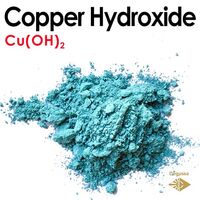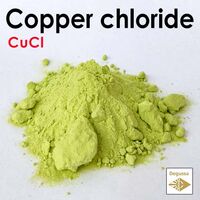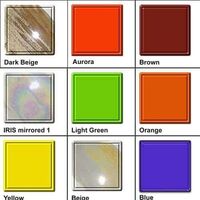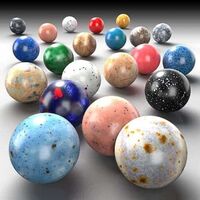Thallium(I) bromide - Thallium non-radioactive halides
TlBr
Thallium(I) bromide is a chemical compound of thallium and bromine with a chemical formula TlBr. This salt is used in room-temperature detectors of X-rays, gamma-rays, and blue light, as well as in near-infrared optics.
Thallium bromide (TlBr) is a chemical compound composed of thallium (Tl) and bromine (Br). It is classified as a metal halide and is primarily used in the field of radiation detection and imaging.
One of the significant applications of thallium bromide is in the production of room-temperature semiconductor radiation detectors. Thallium bromide detectors are sensitive to gamma rays and X-rays, making them valuable for various industries, including medical imaging, security screening, and nuclear power plants. These detectors offer advantages such as high stopping power for radiation, good energy resolution, and the ability to operate at room temperature.
In medical imaging, thallium bromide detectors can be used for gamma camera systems, which are utilized in nuclear medicine for diagnostic purposes, such as detecting and imaging radioactive tracers in the human body. Thallium bromide-based detectors also find applications in non-destructive testing and security screening systems, where they help identify and analyze potentially hazardous materials or detect illicit substances.
It's worth noting that while thallium bromide has useful properties for radiation detection, thallium itself is a highly toxic element. Therefore, proper handling and safety precautions are necessary when working with thallium-containing compounds to ensure the protection of individuals and the environment.
It is a semiconductor.
Like the analogous silver compounds, TlCl, TlBr, and TlI are photosensitive and display poor solubility in water. The stability of thallium(I) compounds demonstrates its differences from the rest of the group: a stable oxide, hydroxide, and carbonate are known, as are many chalcogenides.
Thallium is extremely toxic and a cumulative poison that can be absorbed through the skin. Acute and chronic effects of ingesting thallium compounds include fatigue, limb pain, peripheral neuritis, joint pain, loss of hair, diarrhea, vomiting, vision loss, and damage to the central nervous system, liver, and kidneys.
More about Thallium can be found on Wikipedia.
Formula: TlBr
Molar Mass: 284.287 g/mol
Form: Yellow crystalline solid
CAS Number: 7789-40-4
EC Number: 232-163-0
IUPAC name: bromothallium
Density: 7.5 g/cm³
Synonyms: Thallium bromide, Thallous bromide, MFCD00011273, NSC 15196, NSC15196, Q419400, Thallium monobromide
Thallium(I) bromide - Thallium non-radioactive halides
- Brand: Degussa
- Product Code: Oxide - Thallium bromide
- SKU: TlBr
- Availability: Out Of Stock
-
19.99€
Available Options
Out of Stock
Related Products
COBALT OXIDE - Cobalt (II,III) Oxide Cobalt Ceramic Pigments and Stains
Co3O4 Cobalt oxide color (Co3O4) is a consistent, reliable oxide and a common colorant in pottery. It is avai..
3.39€ 3.99€
Copper Hydroxide - Cupric hydroxide patina for ceramics - cuoh
Cu(OH)2 Copper(II) hydroxide is the hydroxide of copper with the chemical formula of Cu(OH)2. It is a pale greenish..
0.99€
Silicon Carbide - Carborundum - mesh 220 & 1200
SiC Silicon carbide (SiC), also known as carborundum, is a hard chemical compound containing silicon and carbon. A ..
0.99€
Copper Chloride - Copper(I) chloride
CuCl Copper(I) chloride, commonly called cuprous chloride, is the lower chloride of copper, with the formula CuCl. ..
0.59€
Tags: oxide

